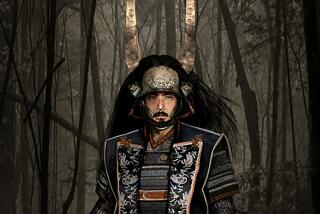MOVIE CAPSULE : ‘PIGS AND BATTLESHIPS’: 1961 JAPANESE FILM
- Share via
“Pigs and Battleships,” which screens at the Fox International Friday through Jan. 8, was reviewed by Kevin Thomas in The Times on June 13, 1979, when it was shown at the County Museum of Art as part of a series of postwar Japanese films. Here are excerpts from that review:
In the early 1960s, Shohei Imamura emerged as one of Japan’s major directors, a vital talent in impassioned protest of the destructiveness of contemporary society upon the individual and his culture. . . His 1961 “Pigs and Battleships” not only is fascinating for what it anticipated in Imamura’s work but also is exciting in its own right. . . .
Set in rowdy Yokosuka, site of a U.S. naval base, it tells of the impact of the stream of American military men upon the city and its people, particularly on an appealing young couple (Hiroyuki Nagato, Jitsuko Yoshimura).
A naive, husky youth always looking for a way to turn a buck, Nagato becomes involved with gangsters attempting to corner the market on hogs with the idea of making a killing providing pork for the U.S. Navy. Yoshimura, who works at a small diner, fears for Nagato and resists the example of her sister, who allows herself to be passed from one American officer to the next, insisting always that she’s a mistress and not an ordinary prostitute.
The plot becomes very complicated with underworld intrigue, but Imamura makes his point clearly: The American presence represents an insidious form of cultural imperialism. However, “Pigs and Battleships” (Times-rated Mature for adult themes) is not a condemnation--Imamura knows how hard pressed and sorely tempted his people are--but rather a warning. It’s also an energetic entertainment, juxtaposing raucous comedy with dark despair within an overall satirical tone. Imamura was subsequently to equate men and animals in the struggle for the survival of the fittest; here, he seems to suggest that the Japanese are letting the Americans lead them into behaving like pigs.
Imamura brings to his film bravura control and a dynamic style, incorporating Toshiro Mayuzumi’s lively, varied and dramatic score and cameraman Shinsaku Himeda’s vivid images of the port’s garish neon jungle that threatens to ensnare Nagato and Yoshimura. It’s safe to say that the film’s climactic sequence, a hilarious stampede of pigs down Yokosuka’s gaudy main drag that abruptly freezes the smile on your face, is unique.
More to Read
Only good movies
Get the Indie Focus newsletter, Mark Olsen's weekly guide to the world of cinema.
You may occasionally receive promotional content from the Los Angeles Times.








